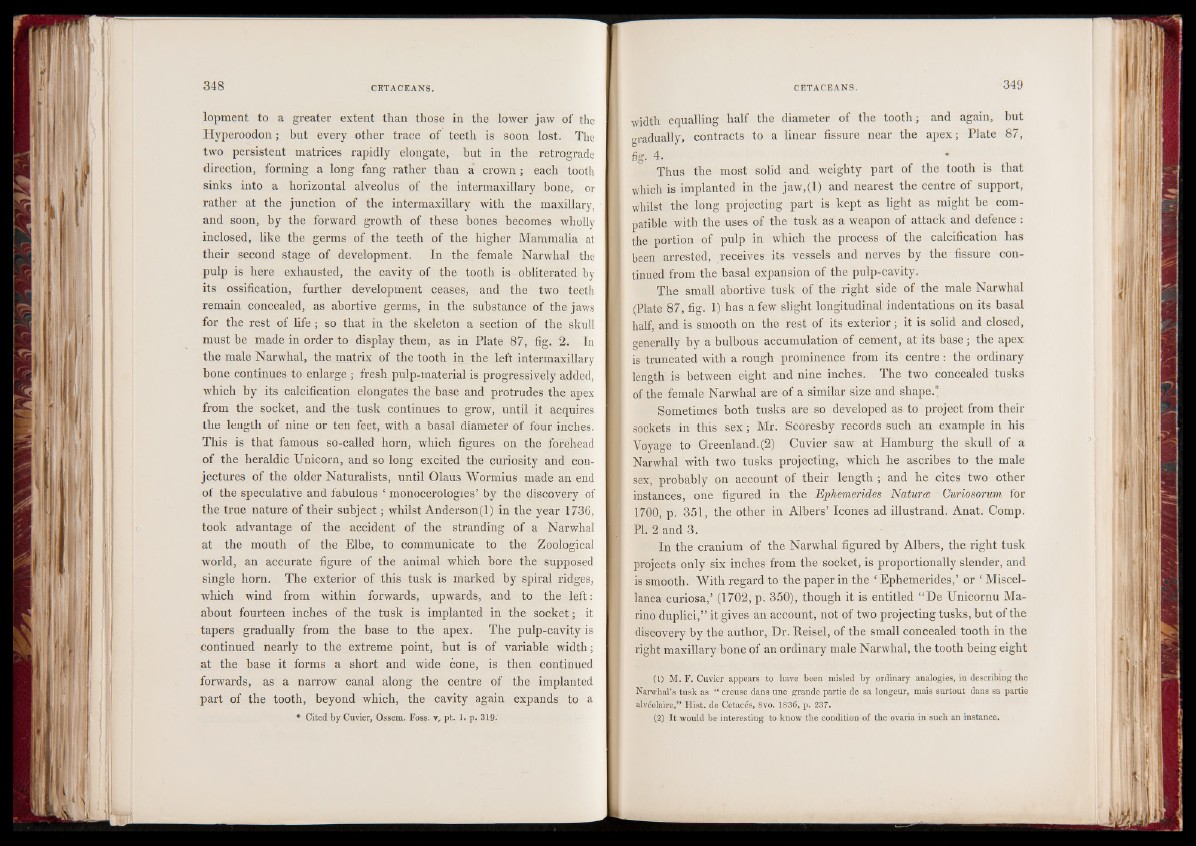
lopment to a greater extent than those in the lower jaw of the
Hyperoodon | hut every other trace of teeth is soon lost. The
two persistent matrices rapidly elongate, but in the retrograde
direction, forming a long fang rather than a crown ; each tooth
sinks into a horizontal alveolus of the intermaxillary bone, or
rather at the junction of the intermaxillary with the maxillary,
and soon, by the forward growth of these bones becomes wholly
inclosed, like the germs of the teeth of the higher Mammalia at
their second stage of development. In the female Narwhal the
pulp is here exhausted, the cavity of the tooth is obliterated by
its ossification, further development ceases, and the two teeth
remain concealed, as abortive germs, in the substance of the jaws
for the rest of life; so that in the skeleton a section of the skull
must be made in order to display them, as in Plate 87, fig. 2. In
the male Narwhal, the matrix of the tooth in the left intermaxillary
hone continues to enlarge ; fresh pulp-material is progressively added,
which by its calcification elongates the base and protrudes the apex
from the socket, and the tusk continues to grow, until it acquires
the length of nine or ten feet, with a basal diameter of four inches.
This is that famous so-called horn, which figures on the forehead
of the heraldic Unicorn, and so long excited the curiosity and conjectures
of the older Naturalists, until Olaus Wormius made an end
of the speculative and fabulous ‘ monocerologies’ by the discovery of
the true nature of their subject; whilst Anderson(l) in the year 1736,
took advantage of the accident of the stranding of a Narwhal
at the mouth of the Elbe, to communicate to the Zoological
world, an accurate figure of the animal which bore the supposed
single horn. The exterior of this tusk is marked by spiral ridges,
which wind from within forwards, upwards, and to the left |
about fourteen inches of the tusk is implanted in the socket; it
tapers gradually from the base to the apex. The pulp-cavity is
continued nearly to the extreme point, hut is of variable width;
at the base it forms a short and wide cone, is then continued
forwards, as a narrow canal along the centre of the implanted
part of the tooth, beyond which, the cavity again expands to a
* Cited by Cuvier, Ossein. Foss, y, pt. 1. p. 319.
width equalling half the diameter of the tooth; and again, but
gradually, contracts to a linear fissure near the apex; Plate 87,
fig. 4T.hus the most solid and weighty part of the tooth is that
which is implanted in the jaw,(l) and nearest the centre of support,
whilst the long projecting part is kept as light as might be compatible
with the uses of the tusk as a weapon of attack and defence :
the portion of pulp in which the process of the calcification has
been arrested, receives its vessels and nerves by the fissure continued
from the basal expansion of the pulp-cavity.
The small abortive tusk of the right side of the male Narwhal
(Plate 87, fig. 1) has a few slight longitudinal indentations on its basal
half, and is smooth on the rest of its exterior; it is solid and closed,
generally by a bulbous accumulation of cement, at its base; the apex
is truncated with a rough prominence from its centre: the ordinary
length is between eight and nine inches. The two concealed tusks
of the female Narwhal are of a similar size and shape/
Sometimes both tusks are so developed as to project from their
sockets in this sex; Mr. Scoreshy records such an example in his
Voyage to Greenland. (2) Cuvier saw at Hamburg the skull of a
Narwhal with two tusks projecting, which he ascribes to the male
sex, probably on account of their length ; and he cites two other
instances, one figured in the Ephemerides Natures Curiosorum for
1700, p. 351, the other in Albers’ leones ad illustrand. Anat. Comp.
PI. 2 and 3.
In the cranium of the Narwhal figured by Albers, the right tusk
projects only six inches from the socket, is proportionally slender, and
is smooth. With regard to the paper in the ‘ Ephemerides,’ or ‘ Miscellanea
curiosa,’ (1702, p. 350), though it is entitled “De Unicornu Marino
duplici,” it gives an account, not of two projecting tusks, but of the
discovery by the author, Dr. Reisel, of the small concealed tooth in the
right maxillary bone of an ordinary male Narwhal, the tooth being eight
(L) M. F. Cuvier appears to have been misled by ordinary analogies, in describing the
Narwhal’s tusk as “ creuse dans une grande partie de sa longeur, mais surtout dans sa partie
alveolaire,” Hist, de Cetaces, 8vo. 1836, p. 237.
(2) It would be interesting to know the condition of the ovaria in such an instance.